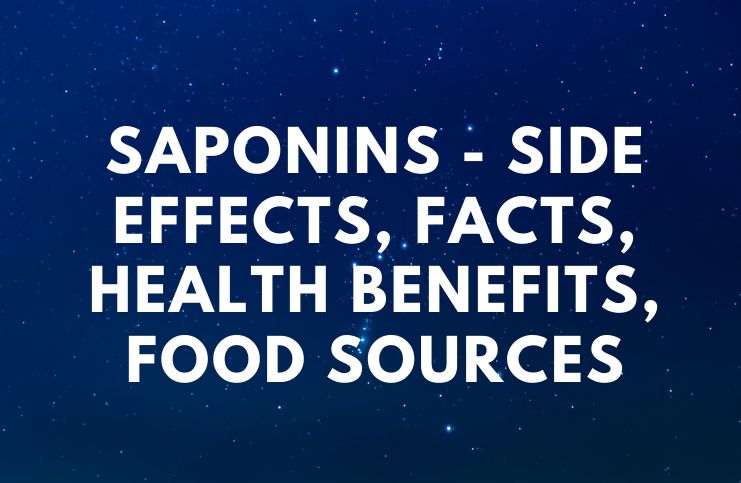Saponins – Side Effects, Facts, Health Benefits, Food Sources:
Saponins are a group of naturally occurring plant glycosides (phytochemicals), possessing detergent qualities that foam when mixed with water. In the animal kingdom, they are found in most starfish and sea cucumbers.
The presence of natural saponins has been reported in more than 100 families of plants, out of which have been found to possess significant anti-cancer properties. The best-known sources are soybeans, peas, chickpeas, mung beans, peanuts, kidney beans, and lentils.
Also, there are some herbs with names indicating foaming capacities, such as soapbark, soapwort, and soapberry. Commercially, they derived from desert plants such as the soapbark tree and the yucca.
Interesting facts and uses
They are widely used for their effects on ammonia emissions in animal feeding. Furthermore, they are used as vaccine adjuvants, due to their ability to modulate the cell-mediated immune system.
In addition, because of their properties, they have been used in a number of cosmetics such as detergents, conditioners, and shampoos, and in the photography industry as photographic emulsions. They are also highly toxic to fish, snakes, and other cold-blooded creatures.
Health Benefits
Cancer prevention
In 2012, there were around 14.1 million cancer cases worldwide, of these 6.7 million in women, and 7.4 million cases were in men. The latest studies have illustrated that they can lower the risk of colon cancer.
Cancer cells also need cholesterol to grow, and they bind cholesterol-rich cancer cell membranes, thereby limiting their growth.
Lowers bad cholesterol
In 2015, according to “Heart Disease and Stroke Statistics,” health data gathered from more than 190 countries show heart disease remains the number 1 global cause of death, with 17.3 million deaths every year.
These compounds are found in Yucca, legumes, and beans (all types) and may lower the bad cholesterol levels (LDL) in your blood by blocking your body’s absorption of cholesterol. It is hypothesized that they either bind with bile salts or cause the bile salts to bind to the polysaccharides in dietary fiber.
Tumor
Ginsenosides, a class of natural saponins that are found in the ginseng plant, have been found to suppress tumor growth and the spreading of tumor cells to other organs, according to researchers in the 2010 review.
HIV
According to a Japanese 1989 study entitled “Inhibitory effect of glycosides like soy saponins on the infectivity of HIV in vitro” by the Department of Virology and Parasitology, Japan, established that soy saponins may have inhibitory activity against HIV infection.
Antioxidant properties
Our physical body produces free radicals naturally, however, we can also take them from the air we breathe or even from our food. Free radicals occurring in the human body can damage and attack cells.
These natural compounds found in plants have also a direct antioxidant activity, which may protect cells against damage from exposure to oxygen, also reducing the risk of cancer and heart disease.
Mineral absorption
They aid the absorption of essential minerals and cause a less irritating effect on the digestive system.
Research from Cornell University points out that saponins in asparagus, oats, beetroot, and spinach actually improve the body’s ability to absorb the minerals silicon and calcium.
Osteoporosis
It is estimated that around 13 percent of the United States white men and 40 percent of the United States white women aged 50 years will experience at least one clinically apparent fragility fracture in their lifetime.
However, though several discoveries have demonstrated ginsenosides to be the most important therapeutic agent for the treatment of osteoporosis, the molecular mechanism of their active metabolites is not clear.
Immune system boosters
Phytochemicals get rid of destructive pathogens in your body. This function naturally cleanses your body, relieves stress on your immune system, and thereby allows it to function more effectively.
Studies concluded that they increase the activity of natural killer cells and the activity of cytotoxic T lymphocytes (a type of white blood cell).
Food sources
The food plants highest in these compounds are – soybeans, chickpeas (also known as garbanzo beans), navy beans (also known as white beans), alfalfa sprouts, red kidney beans, haricot beans, asparagus, garlic, amaranth, quinoa, oatmeal, oat bran, potatoes, spinach, and peanuts.
Noite – removing the content of these compounds from quinoa (a pseudo-cereal) by rinsing prior to cooking also removes the bitter taste, caused by the content of these compounds in the outer seed coat layer of quinoa.
Side effects of saponins
Due to the fact that they come from natural plant sources, including yucca, soybeans, red kidney beans, chickpeas, white beans, and alfalfa, as well as other vegetables and herbs, there are no known negative side effects from having them in your daily diet.
Furthermore, their molecules are ”non-systemic,” meaning they do not penetrate the rest of the body (they do all their work within the intestinal tract), consequently having no harmful side effects.
READ THIS NEXT:
Flavonoid Foods List: Everything You Need to Know
Spirulina Powder – Side Effects
References http://www.cell.com/trends/plant-science/abstract/S1360-1385(96)80016-1 http://www.ncbi.nlm.nih.gov/pubmed/15117556 http://www.ncbi.nlm.nih.gov/pubmed/8853958 http://www.ncbi.nlm.nih.gov/pubmed/2574582 http://www.ncbi.nlm.nih.gov/pmc/articles/PMC3818951/


